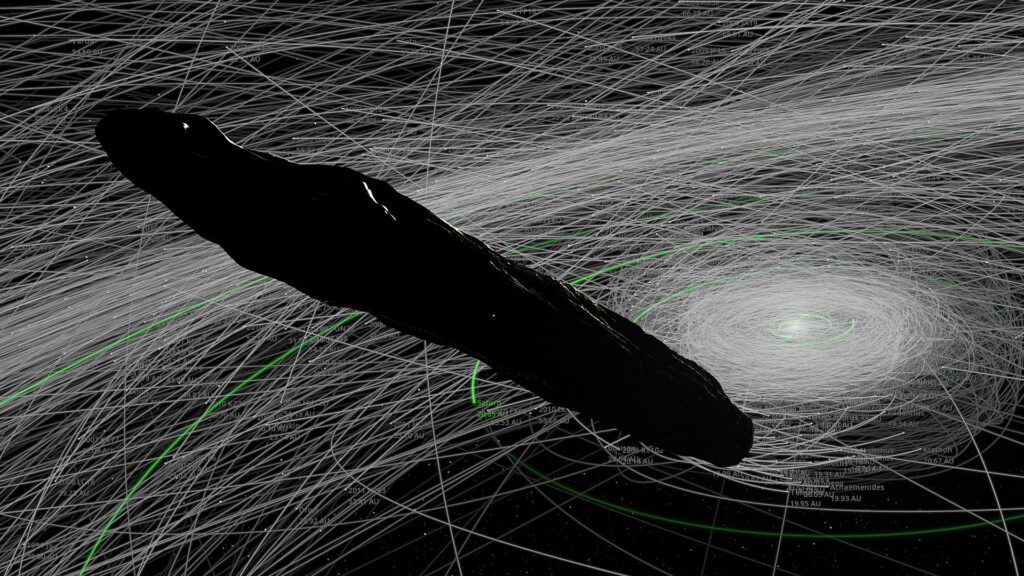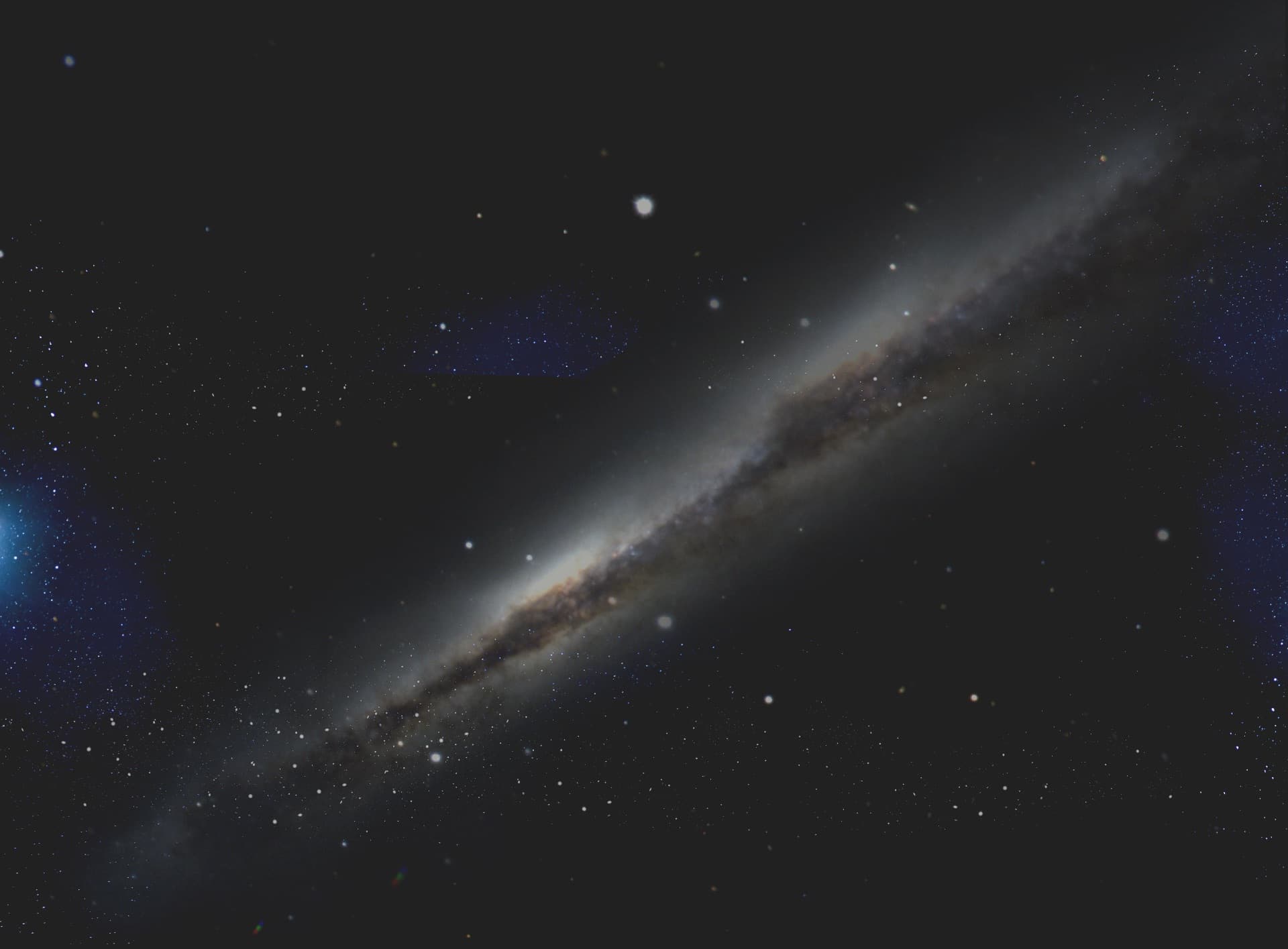In my post last week, I showed the orbit of asteroid ‘Oumuamua in my Solar System section; I used SpaceEngine to create that image. When I fired-up SpaceEngine this week, I was still sitting at ‘Oumuamua. I enabled asteroid orbits, and my jaw nearly hit the floor! The torus of the main asteroid belt, and a wide swath of the Kuiper belt are easily visible! After some indeterminate amount of time just staring at it, I said “Well, I have to get a screen-shot of that!”

Credit: Bob Trembley / SpaceEngine.
- The Sky
- The Moon
- The Sun
- Asteroids
- Fireballs
- The Solar System
- Spacecraft News
- Exoplanets
- Aurora
- Light Pollution
- The Universe

Mars continues to appear in the constellation Taurus, high in the southwestern sky after sunset this week; the Moon appears near the star Pollux in the constellation Gemini on March 23rd.

The Moon appears near the star Regulus in the constellation Leo, high in the southeastern sky after sunset on March 25th.
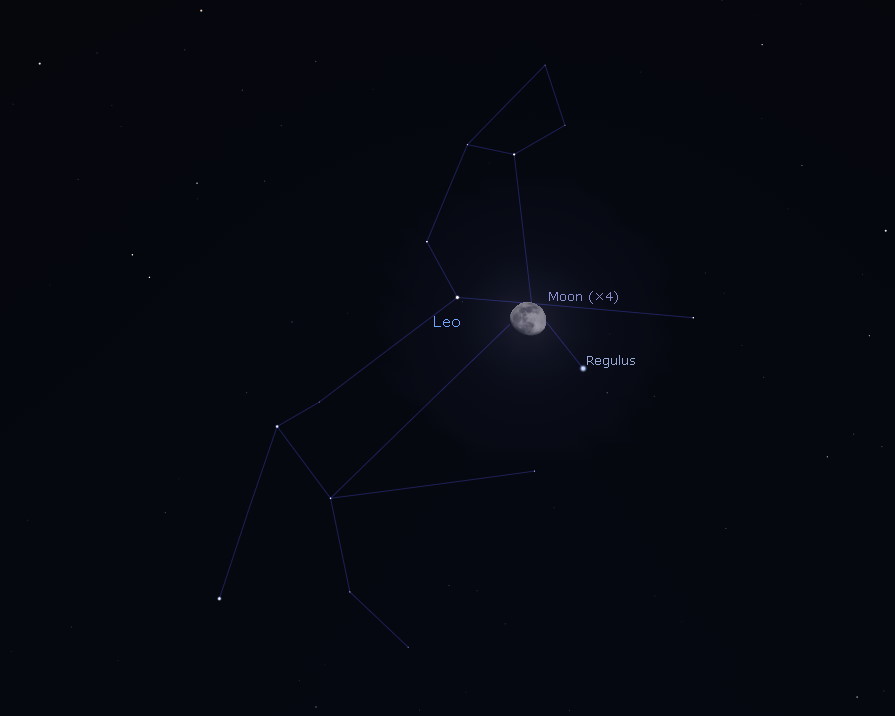
Stellarium has multiple skylore sets – several include constellation-lines and sky-artwork for different cultures and authors.
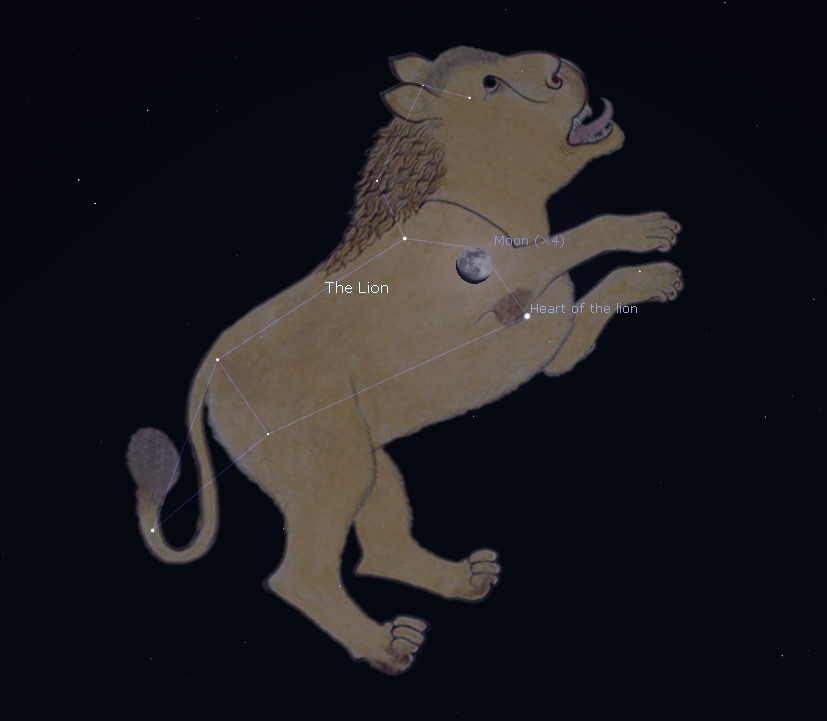
Seen with a far-infrared survey overlay, the constellation Leo appears with wispy clouds of the Interstellar Medium.
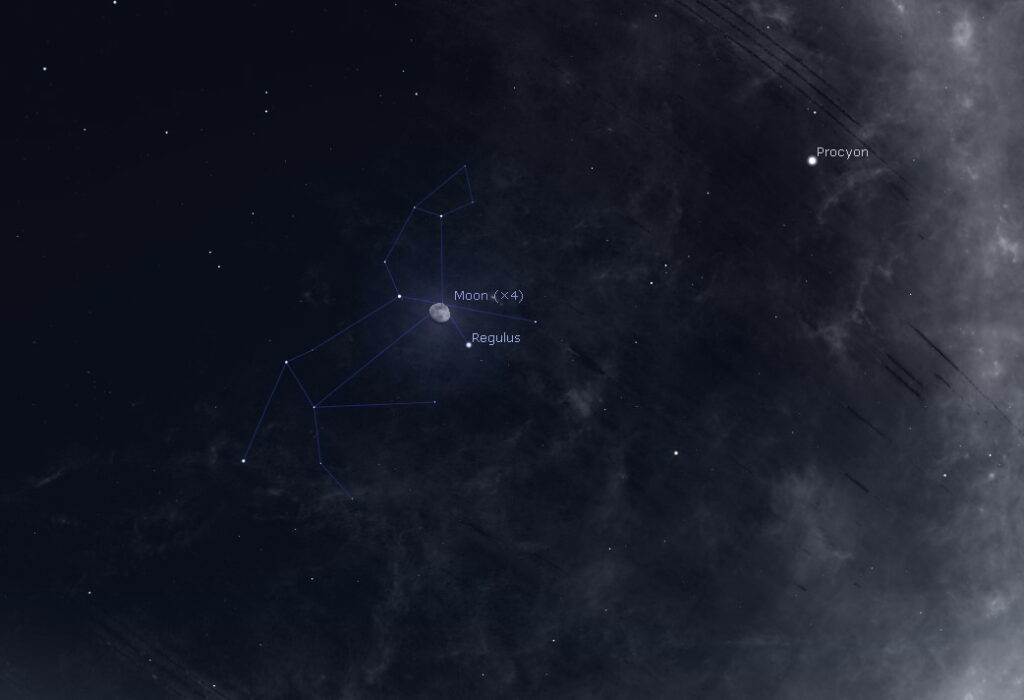
Jupiter and Saturn appear low above the southeastern horizon before dawn all week; Mercury, visible last week, is now lost in the glare of the Sun.
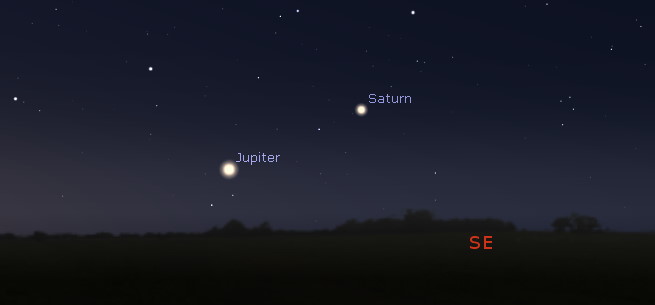
The Moon appears near the star Spica in the constellation Virgo, in the southeastern sky at midnight on March 29th.
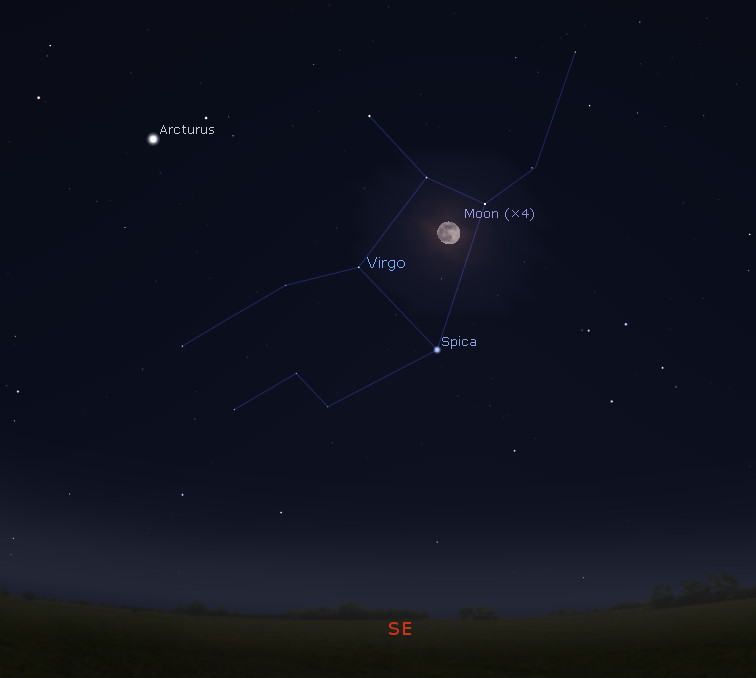
The Summer Triangle is an asterism of the stars Deneb, Vega and Altair – it rises in the eastern sky before dawn.
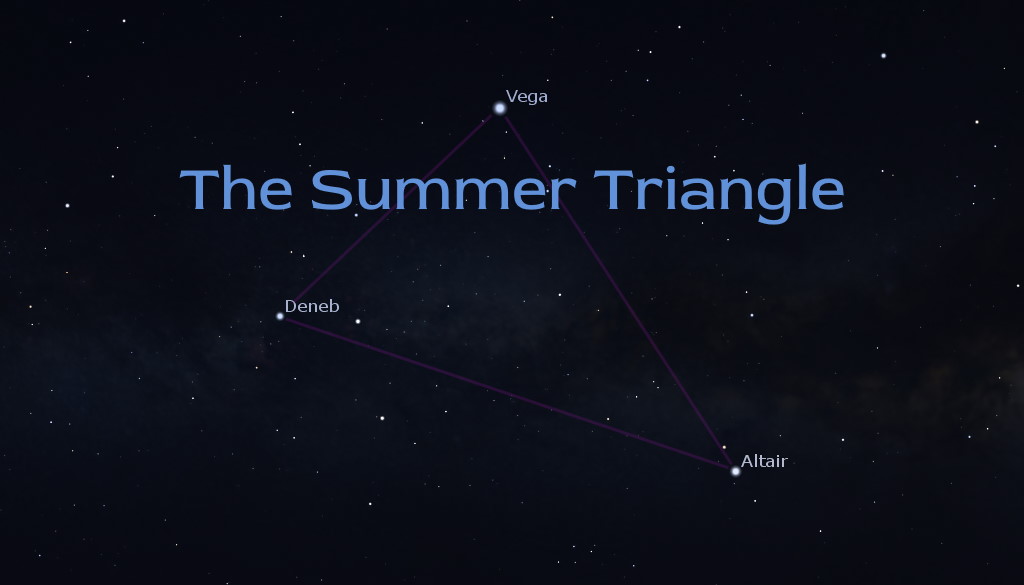

The Moon is a waxing gibbous – visible to the southeast in early evening, and up for most of the night. This is a great time for telescope observing!
The Full Moon occurs on March 28th – rising at sunset, visible high in the sky around midnight, and visible all night.
After March 28th, the Moon will be a waning gibbous – rising after sunset, visible high in the sky after midnight, and visible to the southwest after sunrise.

If you click on the Moon image above, or click this link, you will go to NASA’s Moon Phase and Libration, 2021 page – it will show you what the Moon looks like right now. If you click the image on that page, you will download a high-rez TIFF image annotated with the names of prominent features – helpful for logging your lunar observations!
Moon Close-Up: Shadows on Copernicus Crater
On March 23rd, the shadow-play across Copernicus crater is fantastic! The shadows on the surrounds of the crater really make it look like a big “splat!” The double-crater to the south of Copernicus is interesting
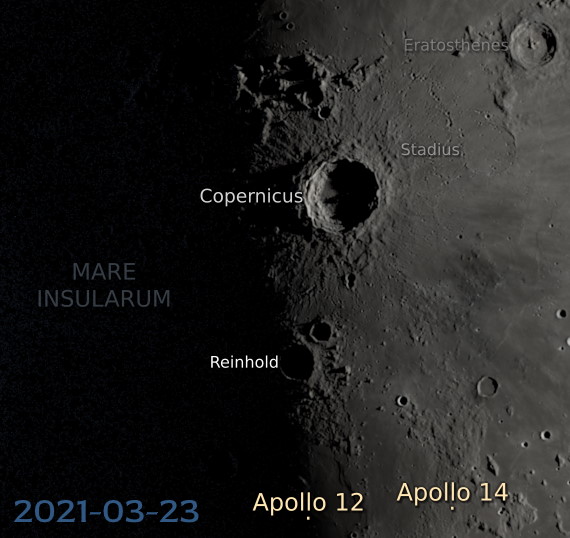
Moon News:


The Sun has 2 named sunspots, SpaceWeather.com says that “most of these northern sunspots are stable and quiet.”
Coronal loop activity, and coronal holes galore, again! The hole at the Sun’s south pole, and the coronal hole above it almost look like a sheet of wallpaper… weird!
Moderate prominence activity for the last couple days; you can a flare blowing off the bright region above the equator!
You can view the Sun in near real-time, in multiple frequencies here: SDO-The Sun Now.
You can create your own time-lapse movies of the Sun here: AIA/HMI Browse Data.
You can browse all the SDO images of the Sun from 2010 to the present here: Browse SDO archive.
Solar Activity on Facebook – Run by Volunteer NASA/JPL Solar System Ambassador Pamela Shivak

Solar Corona
Solar wind speed is 510.0 km/sec, with a density of 5.9 protons/cm3 at 1219 UT.
Near real-time animation of the corona and solar wind from the Solar & Heliospheric Observatory (SOHO):

Sun News

Potentially hazardous asteroids: 2172 (-2, updated 2021-03-23)
Total Minor Planets discovered (NASA): 1,068,751 (+516)
Total Minor Planets discovered (MPC): 1,043,047 (updated 2021-03-16)
Upcoming Earth-asteroid encounters:
| Asteroid |
Date(UT)
|
Miss Distance
|
Velocity (km/s)
|
Diameter (m)
|
| 2021 FT1 |
2021-Mar-22
|
1.4 LD
|
19.5
|
45
|
| 2021 FO1 |
2021-Mar-23
|
0.8 LD
|
7.5
|
5
|
| 2021 FH |
2021-Mar-23
|
0.6 LD
|
12
|
17
|
| 2021 FU |
2021-Mar-24
|
5.4 LD
|
8.9
|
12
|
| 2021 FV |
2021-Mar-24
|
2.2 LD
|
10.6
|
7
|
| 2021 FM1 |
2021-Mar-24
|
13.5 LD
|
13.2
|
28
|
| 2021 FK1 |
2021-Mar-24
|
1.5 LD
|
13.5
|
13
|
| 2021 FQ |
2021-Mar-25
|
5.2 LD
|
7.6
|
13
|
| 2021 EV3 |
2021-Mar-25
|
18.9 LD
|
17.9
|
91
|
| 2021 CX5 |
2021-Mar-27
|
7.7 LD
|
5.6
|
48
|
| 2021 FK |
2021-Mar-27
|
9.2 LD
|
8.5
|
29
|
| 2020 GE |
2021-Mar-27
|
12.7 LD
|
1.5
|
8
|
| 2021 FA1 |
2021-Mar-28
|
3.6 LD
|
3.9
|
6
|
| 2021 FD1 |
2021-Mar-31
|
10 LD
|
9.3
|
17
|
| 2019 GM1 |
2021-Mar-31
|
15.1 LD
|
3.9
|
14
|
| 2021 FT |
2021-Apr-02
|
4.3 LD
|
5.4
|
15
|
| 2015 MB54 |
2021-Apr-06
|
13.6 LD
|
3.7
|
57
|
| 2020 GE1 |
2021-Apr-07
|
12.2 LD
|
4.2
|
14
|
| 2014 FO38 |
2021-Apr-07
|
16.8 LD
|
8.3
|
20
|
| 2021 EH4 |
2021-Apr-08
|
13.1 LD
|
7.7
|
36
|
| 2020 UY1 |
2021-Apr-15
|
16 LD
|
8.7
|
22
|
| 2017 HG4 |
2021-Apr-16
|
7.6 LD
|
4.1
|
10
|
| 2020 HE5 |
2021-Apr-17
|
8.5 LD
|
4.3
|
10
|
| 2019 HQ |
2021-Apr-20
|
14.8 LD
|
8.8
|
20
|
| 2020 HO5 |
2021-Apr-22
|
16.5 LD
|
3.3
|
7
|
| 2019 PS1 |
2021-Apr-23
|
14.5 LD
|
10
|
16
|
| 2016 QE45 |
2021-Apr-24
|
13.2 LD
|
15.3
|
162
|
| 2015 HA177 |
2021-Apr-26
|
18.7 LD
|
8.7
|
10
|
| 2019 HF4 |
2021-Apr-26
|
7.8 LD
|
6.8
|
11
|
| 2021 EZ4 |
2021-Apr-29
|
14.9 LD
|
2.5
|
23
|
| 2019 VT3 |
2021-May-01
|
12.1 LD
|
5.9
|
8
|
| 2021 AF8 |
2021-May-04
|
8.8 LD
|
9.4
|
344
|
| 2018 JP |
2021-May-05
|
10.6 LD
|
7.8
|
12
|
| 2021 AE4 |
2021-May-06
|
18.5 LD
|
9.1
|
153
|
| 2015 KJ19 |
2021-May-14
|
15.1 LD
|
23
|
118
|
| 478784 |
2021-May-18
|
15.8 LD
|
5
|
27
|
Notes: LD means “Lunar Distance.” 1 LD = 384,401 km, the distance between Earth and the Moon. Red highlighted entries are asteroids that either pass very close, or very large with high relative velocities to the Earth. Table from SpaceWeather.com
Asteroid News: Asteroid 2001 FO32 Flyby
 On March 15, 2021, the NASA All Sky Fireball Network reported 2 fireballs!
On March 15, 2021, the NASA All Sky Fireball Network reported 2 fireballs!
(2 sporadics)
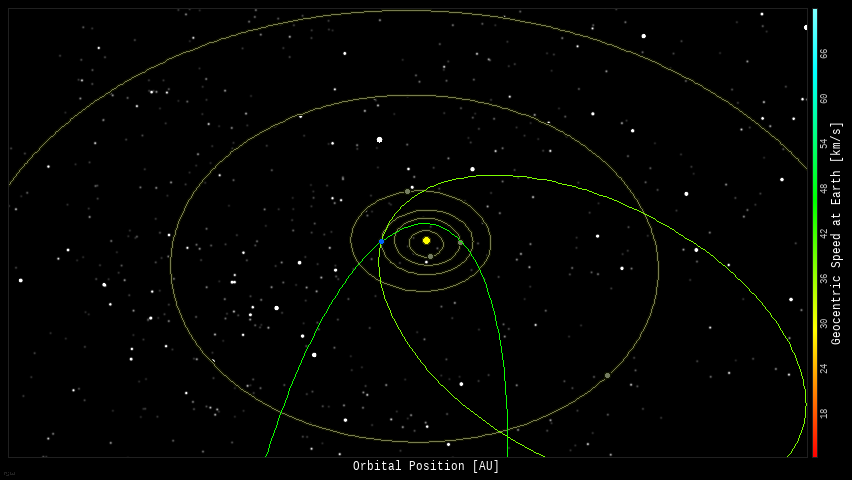
Fireball News
If you see a bright meteor or a fireball, please REPORT IT to the American Meteor Society and the International Meteor Organization!

Position of the planets and several spacecraft in the inner solar system:

Position of the planets in the middle solar system:

For the position of the planets, and a boatload of asteroids in the outer solar system, see the image at the top of this post!

Mars Perseverance Rover:
International Space Station:
When maneuvering your big, heavy spacecraft near the Space Station, you move VERY SLOWLY!!!!
HiRISE – on the Mars Reconnaissance Orbiter:
Hubble Space Telescope:
OK… Want this now!
Climate:
See a list of current NASA missions here: https://www.jpl.nasa.gov/missions/?type=current

ex·o·plan·et /ˈeksōˌplanət/, noun: a planet orbiting a star other than the Sun.
Data from the NASA Exoplanet Archive
* Confirmed Planets Discovered by TESS refers to the number planets that have been published in the refereed astronomical literature.
* TESS Project Candidates refers to the total number of transit-like events that appear to be astrophysical in origin, including false positives as identified by the TESS Project.
* TESS Project Candidates Yet To Be Confirmed refers to the number of TESS Project Candidates that have not yet been dispositioned as a Confirmed Planet or False Positive.
Exoplanet News


SpaceWeather.com Realtime Aurora Gallery: https://spaceweathergallery.com/aurora_gallery.html

Visit an International Dark Sky Park: https://www.darksky.org/our-work/conservation/idsp/parks/

For Teachers: Quiz – Precipitation and the Water Cycle:
New nova in Cassiopeia!
Hubble – Beautiful Universe: Shadow-Play on Saturn’s Rings

Vertical structures, among the tallest seen in Saturn’s main rings, rise abruptly from the edge of Saturn’s B ring to cast long shadows on the ring in this image taken by NASA’s Cassini spacecraft two weeks before the planet’s August 2009 equinox.
Part of the Cassini Division, between the B and the A rings, appears at the top of the image, showing ringlets in the inner division.
In this image, Cassini’s narrow angle camera captured a 1,200-kilometer-long (750-mile-long) section arcing along the outer edge of the B ring. Here, vertical structures tower as high as 2.5 kilometers (1.6 miles) above the plane of the rings — a significant deviation from the vertical thickness of the main A, B and C rings, which is generally only about 10 meters (about 30 feet).
Cassini scientists believe that this is one prominent region at the outer edge of the B ring where large bodies, or moonlets, up to a kilometer or more in size, are found. It is possible that these bodies significantly affect the ring material streaming past them and force the particles upward, in a “splashing” manner.
This image and others like it (see PIA11669) are only possible around the time of Saturn’s equinox, which occurs every half-Saturn-year, or about every 15 Earth years. The illumination geometry that accompanies equinox lowers the sun’s angle to the ring plane and causes structures jutting out of the plane to cast long shadows across the rings. The “season” of equinox allows shadows to appear on the rings in the months before and after equinox, but the actual equinox occurred August 11, 2009, as the sun shone directly edge-on to the ring plane.
This view looks toward the southern, sunlit side of the rings from about 32 degrees below the ring plane.
The image was taken in visible light with the Cassini spacecraft narrow-angle camera on July 26, 2009. The view was acquired at a distance of approximately 336,000 kilometers (209,000 miles) from Saturn and at a sun-Saturn-spacecraft, or phase, angle of 132 degrees. Image scale is 2 kilometers (1 mile) per pixel.
The Cassini-Huygens mission is a cooperative project of NASA, the European Space Agency and the Italian Space Agency. The Jet Propulsion Laboratory, a division of the California Institute of Technology in Pasadena, manages the mission for NASA’s Science Mission Directorate, Washington, D.C. The Cassini orbiter and its two onboard cameras were designed, developed and assembled at JPL. The imaging operations center is based at the Space Science Institute in Boulder, Colo.
For more information about the Cassini-Huygens mission visit http://saturn.jpl.nasa.gov/. The Cassini imaging team homepage is at http://ciclops.org.
Special Note: Seeing Sky Surveys in Stellarium:
The last time I posted a image from Stellarium with a sky survey overlay, a reader asked me how to do that: press F2 (Configuration Window), click on the Surveys tab, check the survey(s) you want to see, wait for it!

Stay safe, be well, and look up!
Software Apps used for this post:
NASA Eyes on the Solar System: an immersive 3D solar system and space mission simulator – free for the PC /MAC. I maintain the unofficial NASA Eyes Facebook page.
SpaceEngine: a free 3D Universe Simulator for Windows. Steam version with VR support available.
Stellarium: a free open source planetarium app for PC/MAC/Linux. It’s a great tool for planning observing sessions. A web-based version of Stellarium is also available.
Section header image credits:
The Sky – Stellarium / Bob Trembley
Observing Target – Turn Left at Orion / M. Skirvin
The Moon – NASA/JPL-Caltech
The Sun – NASA/JPL-Caltech
Asteroids – NASA/JPL-Caltech
Fireballs – Credited to YouTube
Comets – Comet P/Halley, March 8, 1986, W. Liller
The Solar System – NASA Eyes on the Solar System / Bob Trembley
Spacecraft News – NASA Eyes on the Solar System / Bob Trembley
Exoplanets – Space Engine / Bob Trembley
Light Pollution – NASA’s Black Marble
Aurora – Bob Trembley
The Universe – Universe Today
